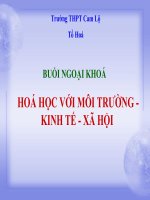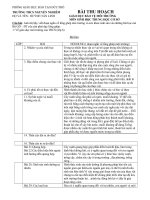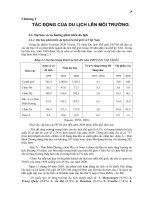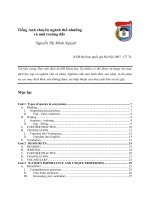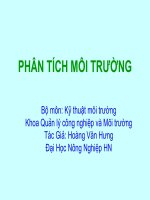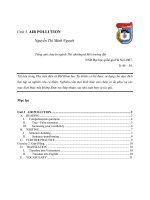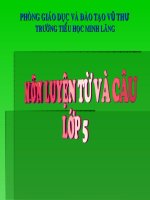Tiếng anh chuyên ngành môi trường
Bạn đang xem bản rút gọn của tài liệu. Xem và tải ngay bản đầy đủ của tài liệu tại đây (2.88 MB, 80 trang )
UNIVERSITY OF TECHNOLOGY
FOREIGN LANGUAGE DEPARTMENT
FOR
ENVIRONMENTAL STUDIES
FOR INTERNAL USE ONLY
UNIT 1 : EN
V
IRONMENT AND ECOLOGY 1
UNIT
1
ENVIRONMENT AND ECOLOGY
WARM-UP
1) What do you think the term environment refers
to?
2) What environmental issues are you concerned
about?
3) Have you ever heard of the word
ecology
?
READING
The term environment broadly indicates the surroundings of an
individual
organism or a community of organisms, ranging on up to the entire
biosphere,
the zone of Earth that is able to sustain life. By surroundings is meant all
the
nonliving and living materials that play any role in an organism's
existence,
from soil and air to what the organism feeds on and the organisms that
may
feed on it. Any other factors acting on the organism, such as heat and light
and
gravitation, make up its environment as well. In the case of human
beings,
cultural factors may also be included in the
term.
Figure
1
2 ENGLISH FOR ENVIRONMEN
T
A
L STUDIES
The environmental science of ecology is the study of the relationship of
plants
and
animals to their physical and biological environment. The
physical
environment includes
light and heat or solar radiation, moisture, wind,
oxygen,
carbon dioxide, nutrients in soil,
water, and atmosphere. The
biological
environment includes organisms of the same kind
as well as other plants
and animals.
Because of the diverse approaches required to study organisms in
their
environment,
ecology draws upon such fields as climatology,
hydrology,
oceanography, physics,
chemistry, geology, and soil analysis. To study
the
relationships between organisms,
ecology also involves such disparate
sciences
as animal behavior, taxonomy, physiology,
and
mathematics.
An increased public awareness of environmental problems has made ecology
a
common
but often misused word. It is confused with environmental
programs
and environmental
science. Although the field is a distinct scientific
discipline,
ecolo gy does
indeed contribute to the study and understanding
of
environmental
problems.
The term ecology was introduced by the German biologist Ernst
Heinrich
Haeckel in
1866; it is derived from the Greek oikos (“household”), sharing
the
same root word as
economics. Thus, the term implies the study of the
economy
of nature. Modern ecology,
in part, began with Charles Darwin. In
developing
his theory of evolution, Darwin
stressed the adaptation of organisms to
their
environment through natural selection.
Also making important
contributions
were plant geographers, such as Alexander von
Humboldt, who were
deeply
interested in the “how” and “why” of vegetational
distribution around
the world.
Figure 2 :
Eco
l
ogy
UNIT 1 : EN
V
IRONMENT AND ECOLOGY 3
READING COMPREHENSION
A.
QUESTIONS
Answer the questions about the
reading.
1) What is
environment?
2) Who is considered to be the founder of modern
ecology?
3) When was the term ecology used for the first
time?
4) What does ecology deal
with?
5) Why does ecology depend on such sciences as climatology,
oceanography,
physics, chemistry, or
geology?
B.
TRUE-FALSE
Write T if the sentence is true and F if it is
false.
1)
_
The term environment also includes cultural
factors.
2)
_
Ecology does not draw upon physiology or
mathematics.
3)
_
_
Ecology does not contribute to the study and understanding
of
environmental
problems
4)
_
Ecology is the study of the interactions of organisms with
their
5)
_
physical and biological
environment
The term ecology was introduced in the mid 19
th
century.
VOCABULARY
Choose the best word or phrase in the box for each of the
following
sentences.
discipline
biosphere
factors
sustain
contributions
environmental
organisms
selection
involves
evolution
1) Ecology focuses on the interactions taking place between
…………………
and their
environments.
2) The study of ecology also includes how the nonliving
………………………
in the environment influence one
another.
3) Darwin's theory of ……………………… was essentially
ecological.
4) When did ecology emerge as a distinct ……………………
?
5) Alexander von Humboldt made significant …………… to
ecology.
6) Ecology also ……………… such disparate sciences as animal
behavior,
taxonomy, physiology, and
mathematics
7) The moon can …………………… life because it does not provide enough
of
what organisms need in order to live or
exist.
4 ENGLISH FOR ENVIRONMEN
T
A
L STUDIES
8) Darwin stressed the adaptation of organisms to their environment
through
natural
……………………….
9) An ………………… movement aims to improve or protect the
natural
environment.
10) The ……………………… is the part of the earth’s surface and atmosphere
in
which plants and animals can
live.
WORD STUDY
A. UN-, IM-, IN-, DIS-, AND
NON-
The prefixes un-, im-, in-, dis-, and non- can be added to the beginning of
some
words. These prefixes mean
“not.”
Look at this
example:
un- + healthy =
unhealthy
Smoking is not good for you. It’s
unhealthy.
Here are other words with these negative
prefixes.
un- unimportant,
unpopular
im-
impossible
in- incomplete,
inexpensive
dis-
discontinue
non-
nonfat
EXERCISE
Choose the best word to complete each
sentence.
1) A person who is unfriendly is probably ………………,
too.
A. unpopular B. unusual C. uncomfortable D.
unimportant
2) The service at this restaurant is very slow. It’s ……………… to have a
quick
lunch
here!
A. impossible B. important C. immoral D.
immediate
3) The airline will ………… service to that city. It is not a popular place to
go.
A. discontinue B. disagree C. disable D.
discover
4) ……………… yogurt is better for you than ice
cream.
A. N on stop B. Nonfat C. Nonst and ard D.
Nonstick
5) Jaime’s homework is ……………… because he felt sick last
night.
A. inexpensive B. incomplete C. inflexible D.
inevitable
UNIT 1 : EN
V
IRONMENT AND ECOLOGY 5
B. ±MENT AND ±ER
Some nouns and verbs have the same form. We can add a special ending,
or
suffix, to other verbs to make noun
forms.
Here are some
examples:
same
form
-ment
-er
verb
noun
verb
noun
verb
noun
order
drink
cost
order
drink
cost
govern
agree
government
agreement
drive
own
run
work
driver
owner
runner
worker
EXERCISE
Complete the sentences with verbs and nouns from the chart. (If you need
to,
make the nouns plural. Also, make sure that each verb agrees with
its
subject.)
1) Susan is the fastest ……………… . She can ……………… the race in
less
than three
minutes.
2) The bus ……………… will not ……………… an unsafe
bus.
3) I think the two companies will ……………… to work together. They
will
both sign the
……………….
4) – Did Saul ……………… a salad and some
tea?
– Yes. Now he’s waiting for his ………………
.
5) Joseph bought a lot of food and ……………… for the get-together. He
hopes
that everyone will eat and ……………… a
lot.
6) Even though they……………… hard, most of the ……………… at
fast-food
restaurants do not make a lot of
money.
7) – My aunt is the ……………… of that popular take-out restaurant on
Main
Street.
– Does she ……………… the restaurant on Green Street,
too?
C. ±TH AND
±
GHT
Some nouns that end in ±th or ±ght are related to similar words that are
not
nouns. Read the following pairs of sentences and see how the words in bold
are
related.
1) Some cities grow quickly. Their growth is
fast.
2) The street is five kilometers long. The length is five
kilometers.
3) The street is fifteen meters wide. Its width is fifteen
meters.
4) The lake is thirty meters deep. Its depth is thirty
meters.
6 ENGLISH FOR ENVIRONMEN
T
A
L STUDIES
5) Joanna is very strong. She has a lot of
strength
.
6) How high is that building? What is its
height
?
7) Anna weighs 50 kilos. Her weight is 50
kilos.
EXERCISE
Now choose the best word for each sentence. Use each word only
once.
depth
height
strength
width
growth
length
weight
1) The flag is flying high above the ground. The …………………of
that
flagpole is about 20
meters.
2) The …………………of the Golden Gate Bridge in San Francisco is
about
1,400 meters. It is a very long
bridge.
3) What is the …………………of the Pacific Ocean at its deepest
point?
4) People who build houses must be very strong. They must have
great
…………………in their
arms.
5) Plants need a lot of water to grow. Without it, their …………………is
slow.
6) What is the …………………of your garage? Is it wide enough to park
two
cars
inside?
7) David is very thin now. He weighs only 49 kilos. He lost a lot
of
…………………
.
STRUCTURE STUDY
THE
PASSIVE
A sentence is often written in a passive form when the important idea is
not
WHO does something, but WHAT IS
DONE.
(a) They measured the extension in the steel
bar.
(b) The extension in the steel bar was
measured.
If the doer of the action has some importance (though less than the object), or
is
needed to complete the sense of the sentence, it is given, e.g. ‘A knowledge
of
statistics is required by every type of
scientists
.’
Passives can be formed in the following
ways:
a) A tense of be + past
participle
active: He coo ked th e
food.
passive: The food was
cooked.
UNIT 1 : EN
V
IRONMENT AND ECOLOGY 7
b) Modal + be / have been + past
participle
active: He m ay cook the
food.
passive: The food may be
cooked.
c) to be / to have been + past
participle
active: He is to cook the
food.
passive: The food is to be
cooked.
d) being / having been + past
participle
active
:
Cooking / Having cooked
…
passive: Being / Having been cooked
…
EXERCISE
Rewrite the following sentences in the passive
:
1) People apply mathematics in many different
activities.
2) People use computers for many different
purposes.
3) People use the decimal system even in countries with
non-decimalized
systems of weights and
measurements.
4) Water covers most of the Earth’s
surface.
5) Somebody was cleaning the room when I
arrived.
6) Huge ocean waves swept houses into the
sea.
7) They have postponed the
seminar.
8) A mystery is something that we can
explain.
9) We are going to build a new zoo next
year.
10) The vegetables didn’t taste very good. People had cooked them for too
long.
11) The situation is serious. We must do something before it’s too
late.
12) When we got to the stadium, we found that they had cancelled the
game.
13) They are building a new ring road round the
city.
14) I don’t like people telling me what to
do.
15) We gave the police the
information.
16) We will give you plenty of time to
decide.
17) They must first clean sewage in treatment
plants.
18) Has anybody told you about
ecology?
19) In modern zoos, people can see animals in more natural
habitats.
20) He said that he wanted somebody to wake him up at 6.30 next
morning.
8 ENGLISH FOR ENVIRONMEN
T
A
L STUDIES
Unit
2
BIOMES AND ECOSYSTEMS
WARM-UP
1) What is the
biosphere?
2) What is a
biome?
3) What is an
ecosystem?
READING
That part of the world where life operates is known as the biosphere.
The
biosphere consists of the air (atmosphere), water (hydrosphere), and
earth
(lithosphere) where living things interact with their environment.
Several
approaches are used to classify its
regions.
The broad units of vegetation are called plant formations by
European
ecologists and biomes by North American ecologists. The major
difference
between the two terms is that biomes include associated animal life.
Major
biomes, however, go by the name of the dominant forms of plant
life.
Figure 3 : Terrestrial
Biomes
UNIT 2 : BIOMES
A
ND ECOSYS
T
EMS 9
Influenced by latitude, elevation, and associated moisture and
temperature
regimes, terrestrial biomes vary geographically from the tropics through
the
arctic and include various types of forest, grassland, shrub land, and
desert.
These biomes also include their associated freshwater communities:
streams,
lakes, ponds, and wetlands. Marine environments, also considered biomes
by
some ecologists, comprise the open ocean, littoral (shallow water)
regions,
benthic (bottom) regions, rocky shores, sandy shores, estuaries, and
associated
tidal
marshes.
A more useful way of looking at the terrestrial and aquatic landscapes is
to
view them as ecosystems, a word coined in 1935 by the British plant
ecologist
Sir Arthur George Tansley to stress the concept of each locale or habitat as
an
integrated whole. A system is a collection of interdependent parts that
function
as a unit and involve inputs and outputs. The major parts of an ecosystem
are
the producers (green plants), the consumers (herbivores and carnivores),
the
decomposers (fungi and bacteria), and the nonliving, or abiotic,
component,
consisting of dead organic matter and nutrients in the soil and water. Inputs
into
the ecosystem are solar energy, water, oxygen, carbon dioxide, nitrogen,
and
other elements and compounds. Outputs from the ecosystem include
water,
oxygen, carbon dioxide, nutrient losses, and the heat released in
cellular
respiration, or heat of respiration. The major driving force is solar
energy.
Relationship among biotic components of the
ecosystem
10 ENGLISH FOR ENVIRONMEN
T
A
L STUDIES
READING COMPREHENSION
A.
QUESTIONS
Answer the questions about the
reading.
1) What is the
biosphere?
2) What is a
biome?
3) Why does terrestrial biomes vary geographically from the tropics through
the
arctic?
4) What is an
ecosystem?
5) What are the major parts of an
ecosystem?
B.
TRUE-FALSE
Write T if the sentence is true and F if it is
false.
1)
_ Plant formations do not include associated animal
life.
2)
__
3)
4)
5)
The major driving force in an ecosystem is solar
energy.
Inputs into the ecosystem do not include carbon dioxide
or
nitrogen.
The term ecosystems was invented by Sir Arthur George
Tansley.
A grassland is not an
ecosystem.
VOCABULARY
Choose the best word or phrase in the box for each of the
following
sentences.
interdependent
influence
comprise
organic
nutrients
interact
abiotic
components
coined
associated
1) Both the biotic and abiotic …………… are equally important in
the
ecosystem.
2) Plants draw minerals and other …………… from the
soil.
3) A system is a collection of …………… parts that function as a
unit.
4) …………… vegetables are produced without using artificial
chemicals.
5) The study of ecology also includes how the nonliving factors in
the
environment …………… one
another.
6) A biome includes …………… animal
life.
7) The biosphere is that part of the world where living things ……………
with
their
environment.
8) The term ecology was …………… by a German zoologist, Ernst
Haeckel.
UNIT 2 : BIOMES
A
ND ECOSYS
T
EMS 11
9) The nonliving factors of the environment make up the
……………
component of the
ecosystem.
10) Marine environments …………… the open ocean, littoral regions,
benthic
regions, rocky shores, sandy shores, estuaries, and associated tidal
marshes.
WORD STUDY
A. COMPOUND
WORDS
A compound word is two smaller words put together. The meaning of
the
compound word is related to the meanings of the two
words.
Here are some
examples:
bird + house = birdhouse (a place for birds to
live)
car + wash = carwash (a place to wash your
car)
EXERCISE
First, make compound words by putting together these pairs of
words.
some + one =
……………………………………
stop + light =
……………………………………
bed + room =
……………………………………
birth + day =
……………………………………
under + line =
……………………………………
note + book =
……………………………………
Now use the compound words to complete the
sentences.
1) In class, students write notes in a
……………………………………
2) I sleep in a bed in my
……………………………………
3) Cars must stop when the …………………………………… is
red.
4) Next week is my 20th …………………………………… . I am going to
have
a party for all my friends. I will be 20 years
old.
5) If the teacher says to put a line under the verb, then we
must
……………………… the
verb.
6) …………………………………… wants to talk to you on the telephone.
I
don’t know who it
is.
12 ENGLISH FOR ENVIRONMEN
T
A
L STUDIES
B. -AL, -ABLE, AND
-FUL
The suffixes -al, -able, and -ful can be added to the end of some words.
These
suffixes mean that something “is full of something” or “has
something.”
Here are some
examples:
Roses are beautiful flowers. (full of
beauty)
Puerto Rico has many coastal cities. (has a
coast)
That is a very comfortable chair. (has
comfort)
When you add these suffixes to a word, the new word becomes an
adjective.
An adjective describes a noun or a pronoun. It usually comes before a noun
or
after the verb
be
.
EXERCISE
Practice making adjectives by adding the suffixes -al, -able, and -ful to
the
following
words.
Spelling Note: Change y to i before -al and
-ful
.
noun (add –al) adjective verb (add -able)
adjective
co ast …………………… … no ti ce
………………………
season ……………………… agre e
………………………
industr y ……………………… en jo y
………………………
nation
………………………
noun (add -ful)
adjective
beauty
………………………
help
………………………
wond er
………………………
Complete each sentence with an adjective from the
lists.
1) Most people in Puerto Rico live in ……………………
cities.
2) The influence of Spain is very …………………… in San
Juan.
3) The people of Puerto Rico are usually …………………… to
tourists.
4) San Juan is a modern, ……………………
city.
5) Puerto Ricans cannot vote in U.S. ……………………
elections.
6) The beaches and mountains of Puerto Rico are
……………………
7) My cousins had a very …………………… time visiting the old city of
San
Juan. They bought some souvenirs and had a delicious
lunch.
8) In general, Puerto Rico is a …………………… place to
visit.
UNIT 2 : BIOMES
A
ND ECOSYS
T
EMS 13
C.
-EN
We can change some nouns and adjectives into verbs by adding the suffix
-en
.
For example, if you add -en to the adjective dark, you get the word
darken
.
Darken means “to make something
dark.
”
EXERCISE
Look at these examples. Complete the
chart.
noun
verb
adjective
verb
strength
length
strengthen
………………………
weak
………………………
short
weaken
widen
………………………
STRUCTURE STUDY
THE PASSIVE
(continued)
When we talk about what other people say, believe, etc we can use two
possible
passive forms.
Compare:
Active: People say that Mr. Ross is a
millionaire
.
Passive (1): It is said that Mr. Ross is a
millionaire
.
Passive (2): Mr. Ross is said to be a
millionaire
.
We often use these passive forms in a formal style and with verbs such as:
say,
think, believe, consider, understand, know, report, expect, allege,
claim,
acknowledge,
fear.
EXERCISE
Read each sentence. Then make two new sentences in the
passive.
1) People expect that taxes will be reduced
soon.
2) People say that the monument is over 2000 years
old.
3) People expect that the president will
resign.
4) People think the fire started at about 8
o’clock.
5) Journalists reported that seven people had been injured in the
fire.
6) They expect that a new law will be introduced next
year.
7) People say that the concert was very
good.
8) People allege that the man drove through the town at 90 miles an
hour.
9) They report that many people are homeless after the
floods.
10) Those two houses belong to the same family. People say that there is a
secret
tunnel between
them.
14 ENGLISH FOR ENVIRONMEN
T
A
L STUDIES
11) They say that the company is losing a lot of
money.
12) People expect that the strike will end
soon.
13) They believed that the workers had stolen the
money.
14) They say that it was designed by Leonardo da
Vinci.
15) They say that there is plenty of oil off our
coast.
16) People know that there are thousands of different species of
beetles.
17) They suppose that George is an expert in financial
matters.
18) They say that thousands of new jobs will be created in the computer
industry.
19) They reported that all the passengers had died in the
crash.
20) They say that there are thousands of people waiting to renew their
passports.
Figure 4 : The
biosphere
UNIT 3 : ENERGY
A
ND NU
T
R
IENTS 15
UNIT
3
ENERGY AND NUTRIENTS
WARM-UP
1) Why is the energy from the sun is essential for
life?
2) Have you ever heard of
photosynthesis?
3) How important is
photosynthesis?
READING
Ecosystems function with energy flowing in one direction from the sun,
and
through nutrients, which are continuously recycled. Light energy is used
by
plants, which, by the process of photosynthesis, convert it to chemical energy
in
the form of carbohydrates and other carbon compounds. This energy is
then
transferred through the ecosystem by a series of steps that involve eating
and
being eaten, or what is called a food web. Each step in the transfer of
energy
involves several trophic, or feeding, levels: plants, herbivores (plant
eaters),
two or three levels of carnivores (meat eaters), and decomposers. Only
a
fraction of the energy fixed
b
y
plants follows this pathway,
known
as the grazing food web. Plant
and
animal matter not used in
the
grazing food chain, such as
fallen
leaves, twigs, roots, tree trunks,
and
the dead bodies of animals,
support
the decomposer food web.
Bacteria,
fungi, and animals that feed
on
dead material become the
energy
source for higher trophic levels
that
tie into the grazing food web.
In
this way nature makes
maximum
use of energy originally fixed
by
plants.
The number of trophic levels
is
limited in both types of food
webs,
Figure 5 : A Food Web
16 ENGLISH FOR ENVIRONMEN
T
A
L STUDIES
because at each transfer a great deal of energy is lost (such as heat
of
respiration) and is no longer usable or transferable to the next trophic
level.
Thus, each trophic level contains less energy than the trophic level
supporting
it. For this reason, as an example, deer or caribou (herbivores) are
more
abundant than wolves
(carnivores).
Energy flow fuels the biogeochemical, or nutrient, cycles. The cycling
of
nutrients begins with their release from organic matter by weathering
and
decomposition in a form that can be picked up
b
y plants. Plants
incorporate
nutrients available in soil and water and store them in their tissues.
The
nutrients are transferred from one trophic level to another through the
food
web. Because most plants and animals go uneaten, nutrients contained in
their
tissues, after passing through the decomposer food web, are ultimately
released
by bacterial and fungal decomposition, a process that reduces complex
organic
compounds into simple inorganic compounds available for reuse by
plants.
Figure 6 : Energy and nutrients cycle
UNIT 3 : ENERGY
A
ND NU
T
R
IENTS 17
Feeding or tropic levels and food
chains
18 ENGLISH FOR ENVIRONMEN
T
A
L STUDIES
READING COMPREHENSION
A.
QUESTIONS
Answer the questions about the
reading.
1) How is light energy converted to chemical
energy?
2) What does a food web consist
of?
3) Why are herbivores more abundant than
carnivores?
4) Why is the number of trophic levels
limited?
5) How are complex organic compounds reduced into simple
inorganic
compounds available for reuse by
plants?
B.
TRUE-FALSE
Write T if the sentence is true and F if it is
false.
1)
_
Each trophic level contains more energy than the trophic
level
supporting
it
2)
_
Plants incorporate nutrients available in soil and water and
store
them in their
tissues.
3)
_
All of the energy fixed by plants is transferred through
the
ecosystem by the grazing food
web.
4)
_
Carnivores are more abundant than
herbivores.
5)
_
Bacterial and fungal decomposition is a process that
reduces
complex organic compounds into simple inorganic
compounds
available for reuse by
plants.
VOCABULARY
Match each of the terms on the left with its definition on the
right.
1)
carnivore
A. any animal that eats only
plants
2)
decomposition
B. a region characterized by similarities in its
vegetation,
living organisms and
climate
3)
herbivore
C. the breakdown of dead plants and animals
by
organisms such as bacteria and
fungi
4)
photosynthesis
D. a substance that is needed to keep a living thing
alive
and to help it to
grow
5)
decomposer
E. any animal that eats
meat
6)
omnivore
F. an animal which obtains its food from plants or
other
animals
UNIT 3 : ENERGY
A
ND NU
T
R
IENTS 19
7)
biome
G. the process in plants by which carbon dioxide
is
converted into organic compounds using the energy
of
light
8)
nutrient
H. an animal that eats all types of food, especially
both
plants and
meat
9)
consumer
I. an organism that produces organic compounds
from
simple
substances
10)
producer
J. any animal uses the bodies of dead animals and
plants
for its
food
WORD STUDY
A.
RE-
The prefix re- means “to do something
again.”
Here is an
example:
re- + read = reread (to read
again)
If you don’t understand a story the first time you read it, then you
should
reread
it.
EXERCISE
Add the prefix re- to each word in the box. Then choose the correct word
to
complete each
sentence.
arrange
do
order
tell
build
married
take
write
1) José made many mistakes in his first composition. Before he gives it to
his
teacher tomorrow, he is going to ………………………
it.
2) Dave and Susan Johnson got divorced 10 years ago. Last year Susan
got
………………… and moved to Canada with her new
husband.
3) I think I should ……………………… the furniture in my apartment.
The
way I have the tables and chairs now makes the room look
crowded.
4) Children love to hear their grandparents tell stories! They often ask
their
grandparents to ……………………… their favorite stories many
times.
5) The new waiter at the restaurant forgot our order for dinner, so we had
to
……………………
everything.
6) If you don’t get a good score on the TOEFL exam this weekend, you
can
…………………… it next
month.
20 ENGLISH FOR ENVIRONMEN
T
A
L STUDIES
B. WORD FORMS:
NOUNS
Sometimes verbs and nouns have the same form. Sometimes we can
change
adjectives and verbs to nouns by adding a suffix or changing the form of
the
word. Look at the nouns below. Notice how they are related to other
words.
-ity
same
form
adjective
noun
verb
noun
change
control
divorce
change
control
divorce
different
form
electric
able
national
necessary
possible
electricity
ability
nationality
necessity
possibility
marry
choose
marriage
choice
EXERCISE
Practice using direct objects. Choose the correct noun form of the word
in
bold print to complete each
sentence.
electric
1) Yesterday there was a big storm and we lost
the
……………………… at school. Everything was
dark!
national
2) Katarina was born in Spain. Her first language and
her
………………… are
Spanish.
marry
3) Parents used to arrange the ……………………… of
their
child. Now people usually marry the person they
love.
control
4) After 1800 mothers usually stayed home and
had
……………………… of the children and the
home.
necessary
5) An education is very important for a good life. Parents
must
explain this ……………………… to their
children.
able
6) My cousin is able to learn languages very quickly. She
uses
this ……………………… in her job as a tour
guide.
choose
7) You must choose which movie to see tonight. I chose
the
movie last week. Now it’s your
……………………….
possible
8) Ali doesn’t know where to go on vacation. He might
choose
Mexico, but Puerto Rico is another
………………………
C. WORD FORMS:
NOUNS
Sometimes in English we can change an adjective to a noun by adding a suffix
or
changing the
spelling.
UNIT 3 : ENERGY
A
ND NU
T
R
IENTS 21
Look at the examples. Complete the
chart.
-ness
t
ce
adjective
noun
adjective
noun
smooth
happy
weak
smoothness
happiness
……………………
important
different
………………………
importance
……………………
silence
When we add a suffix to some verbs, we can make nouns. Sometimes a
verb
and a noun have the same
form.
Look at these
examples.
-ture
-er
same
form
verb
noun
verb
noun
verb
noun
mix
sign
furnish
mixture
signature
furniture
explore
dry
wash
explorer
dryer
washer
change
work
start
change
work
start
EXERCISE
Complete each sentence with the correct form of the word in bold
print.
change
1) The teacher explained the reason for the
………………………
in the class
schedule.
different
2) Modern and traditional clothes are different. Do
you
understand the
………………………?
explore
3) James Cook is the name of an
……………………….
furnish
4) What kind of ……………………… do you have in
your
apartment?
happy
5) Money does not always bring
……………………….
important
6) Social scientists do not understand the
………………………
of animal carvings in Eskimo
society.
mix
7) To make lemonade, mix lemon juice and water. Then
add
sugar to the ………………………
.
sign
8) There is a place for your ……………………… at the
bottom
of the application. Please sign
it.
silent
9) You can almost hear the ……………………… in
northern
Canada. It is very peaceful
there.
smooth
10) Handling the carvings makes them smoother,
and
……………………… improves
them.
start
11) The students finished their homework in the cafeteria only
five
minutes before the ……………………… of
class.
work
12) What kind of ……………………… did you do in your
native
country?
22 ENGLISH FOR ENVIRONMEN
T
A
L STUDIES
STRUCTURE STUDY
THE
CAUSATIVE
Form
have object
past
participle
I am
having
How often do you
have
We
had
Simon has just
had
You should
have
Are you going to
have
a
garage
your
hair
our
computer
a
suit
your
eyes
new
carpets
built at the
moment.
cut
?
serviced last
week.
made
.
tested
.
fitted in your
flat?
Use
We use the structure have something done to talk about something which
we
arrange for someone else to do for
us.
Compare:
,¶m building a garage at the moment. (I am building the garage
myself.)
,¶m having a garage built at the moment. (I arranged for someone else to
do
this for
me.”
We can also use have something done when we do not arrange for
someone
else to do something for
us.
I had my leg broken in a football
match.
We had our fence blown down in a storm last
week.
We often use have something done un this way when something unpleasant
or
unexpected happens to
someone.
Note that we can often use get something done instead of have something
done
especially in an informal style e.g. I must get this jacket
cleaned.
EXERCISE
Complete the sentences using the correct form of having something
done
.
1) Are you going to ……………………………………… or shall I throw
them
away? (these shoes /
repair)
2) My neighbors are ……………………………………… onto their house
at
the moment. (an extension /
build)
3) I must ……………………………………… They keep falling off.
(my
glasses /
mend)
4) Where do you …………………………………? It always looks very
nice.
(your hair /
do)
UNIT 3 : ENERGY
A
ND NU
T
R
IENTS 23
5) I ……………………………………… on my car last month. (four new tires
/
fit)
6) I’ve just ……………………………………… (my suit /
dry-clean)
7) Peter ……………………………………… while he was out at work. (his
flat
/
burgle)
8) Mr. and Mrs. Woods ……………………………………… in a storm.
(the
roof of their house /
damage)
9) Kate ……………………………………… from her bag while she was
out
shopping. (her wallet /
steal)
10) My brother ……………………………………… in a football match.
(his
nose /
break)
Figure
7
